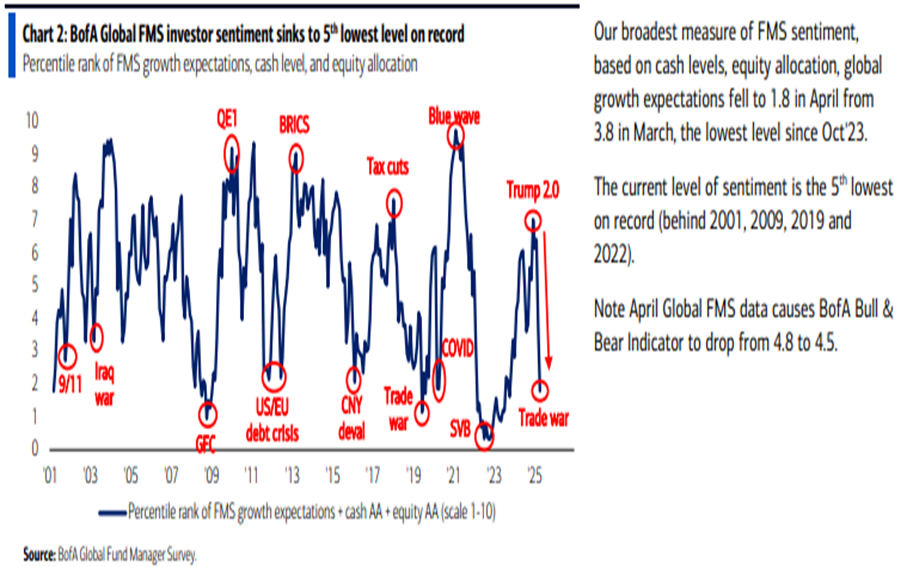Despite the ongoing volatility, last week’s volume and price action suggested a good likelihood of a short-term low in place for US stocks, which might now be followed by a push higher in a “2-steps forward, one-step back” type process into May. Multiple technical factors came together last week to show an inflection coinciding with breadth and volume capitulation at a time when sentiment had reached the most negative levels in years. Technology’s rebound from support last week is certainly a reason for optimism, and along with strength in Financials, it should be able to drive markets higher in the months to come. Thus, while trends and momentum remain negative from mid-February, seasonality and cycles show a rally developing following signs of tariff fatigue from Equities, and breadth has improved following the best one-week performance in SPX since 2023. Going forward, SPX 5500, QQQ-466.43 and DJIA-40,661 remain key areas to exceed to have confidence, and these likely are tested and exceeded as the rally likely gains momentum over the next week. At this point, it remains premature for me to consider this a bear market, nor that the US Economy should enter a recession.
The final day of trading in this holiday shortened week saw much better performance than SPX might have indicated, and market breadth proved to be meaningfully better on Thursday as a positive, than the negative breadth readings for Wednesday.
While the lack of upward progress is a concern to many investors who have grown impatient with the absence of strength out of Technology, I’m still of the opinion that the low from last Monday (4/7) was important given the breadth and volume dispersion that occurred directly surrounding this day.
At present, a mild rally has gotten underway that will need to eclipse 5386 to begin to show more upside acceleration. The burden of proof is clearly on the bulls at this point given an ongoing negative technical trend coupled with strong negative weekly momentum.
However, as discussed in notes over the past week, seeing Technology bottom where it needed to based on long-term trends, along with the SPX having held its uptrend from 2022 lows, does look important and positive.
My personal opinion is that tariffs have reached their maximum possible level, and that negotiations with both Japan and the EU, along/with China, all have the potential to cause “upside surprises” if and when they’re announced. Thus, it’s arguably right to favor a bounce into May given the constructive price action since 4/7, even if price action has proven wobbly of late.
S&P 500 Index
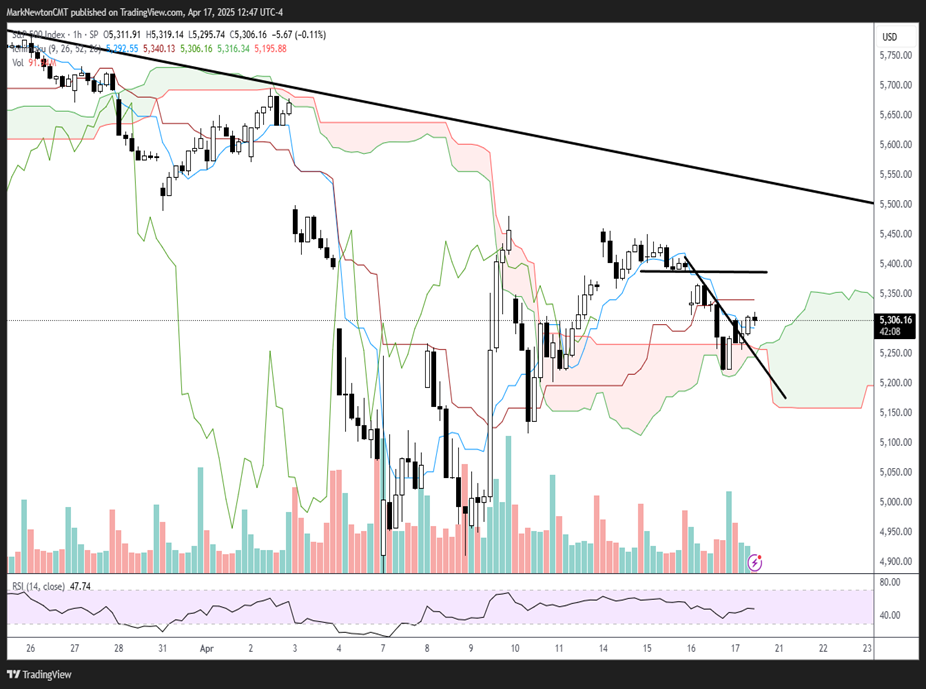
SPX pulled back further to multi-week lows vs. All Country World index this past week
Overall, it’s still hard to argue for an imminent snapback in the performance of US stocks compared to the ACWX (All Country World index (Ex-US)).
While the larger uptrend remains very much intact, the short-term damage has not yet begun to stabilize and turn back higher.
Weekly ratio charts of SPY vs ACWX show this short-term downtrend as part of the longer-term uptrend. If DeMark exhaustion counts were to finish a TD Buy Setup count before the SPY starts to act better vs. the World indices, that would imply a possible additional 4-6 weeks of US underperformance.
While my work shows SPX starting a move back higher between Spring 2025 into this coming Fall, it’s still possible that SPY might take a bit more time before relative strength out of the US vs the World starts to get underway. As shown below, four straight months of weakness has not done damage to the intermediate-term bullish longer-term trend.
Chart below highlights SPY vs. ACWX. Thus, there remains short-term weakness only (US underperformance) as part of a long-term uptrend in US performance vs ACWX.
SPY/ACWX
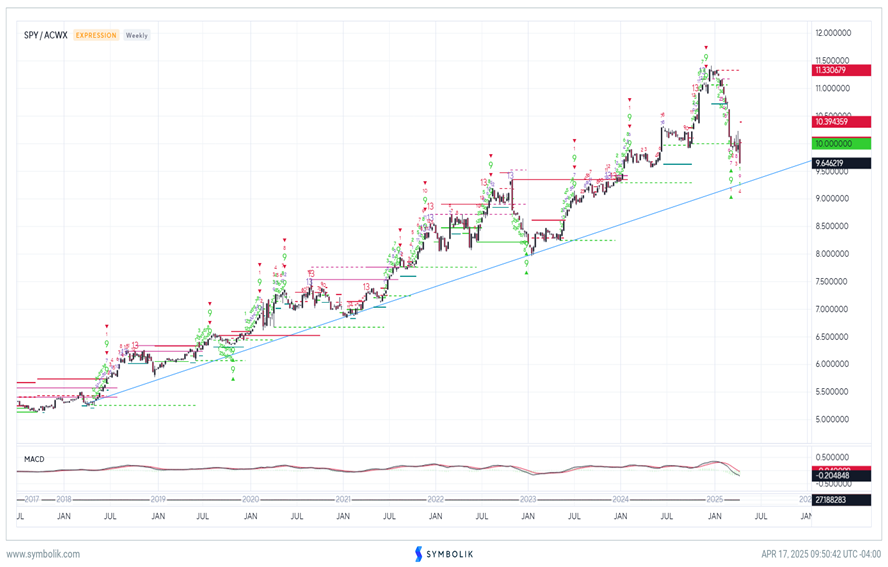
US Treasury yields likely follow German Bund yields lower
German Bund yields broke down sharply on Thursday following Lagarde’s suggestion that downside risks have increased (following the EU’s decision to cut rates by 25 b.p.).
As shown below, this decline in Bund yields has broken the uptrend from last December’s lows. US yields have also been retreating over the last week and cycles show US 10-Year Treasury yields as having a good likelihood of peaking out and pulling back into the month of August before much support and upward reversal gets underway.
Thus, at a time when many have been fearful of higher rates and inflation, it’s worth noting that the bounce which occurred in both US and also European sovereign bond yields looks to have proven short-lived. My expectation is that both US and German Bund yields trend lower in the months ahead.
German 10-Year Yields Drop as Lagarde Flags Growth Risks
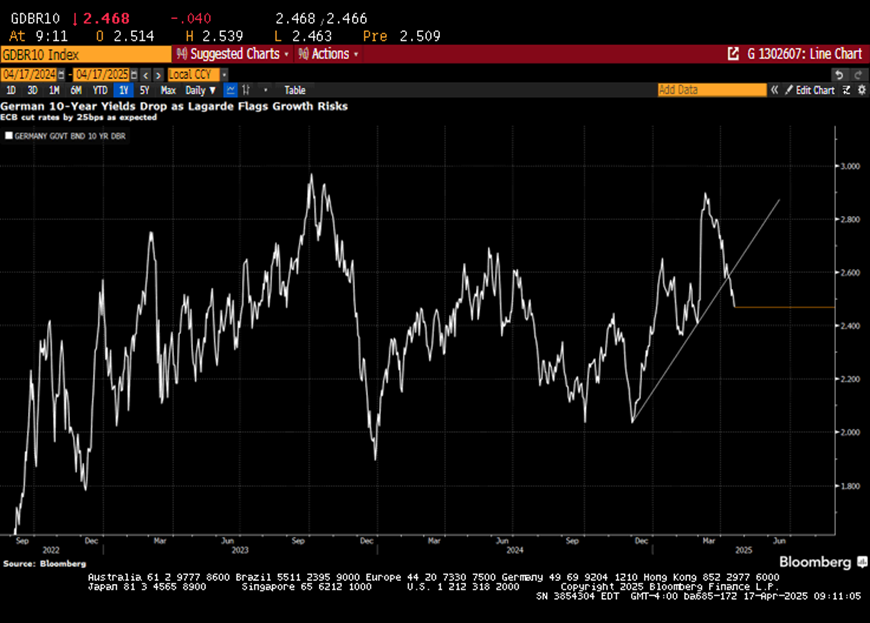
US Dollar likely continues lower into next week before a minor bounce
As shown below, the US Dollar decline (as per DXY- US Dollar Index) has reached the lowest levels since 2022 and showed signs of extending losses this week, marking its 11th week of losing ground out of the last 14 weeks since the January 2025 peak.
While many are concerned about the EURUSD recent gains given Lagarde’s downbeat talk about growth risks rising for Europe, there aren’t yet any signs of the Dollar starting to reverse course that would make a bounce seem imminent.
Counter-trend exhaustion signals seem at least one week away and will require a bit more weakness in DXY before both daily and weekly signals emerge which might mark a rally.
Positioning still looks to have room to grow more bearish after CFTC data showed Net-long positioning (as a percentage of Open interest in the Dollar vs. all Emerging market and Developed market currencies) hit 10-year highs back in January. While this has reversed to bearish positioning as of the last month (positioning is now net short), it looks like there is further room to fall before this reaches extremes that have traditionally yielded to sharp upside reversals.
At present, counting on 1-2 weeks of further DXY erosion looks correct, technically, along with expecting that any bounce also might prove short-lived.
While a possible August-December 2025 bounce could happen in the US Dollar index, the intermediate-term trend has turned more negative given the extent of the weakness in recent months. Thus, intermediate-term downside targets for DXY lie in the low 90’s.
I’ll discuss a possible turning point for DXY back higher along with the potential for EURUSD to make a short-term top when further signs arise in the next 1-2 weeks.
DXY-DXY
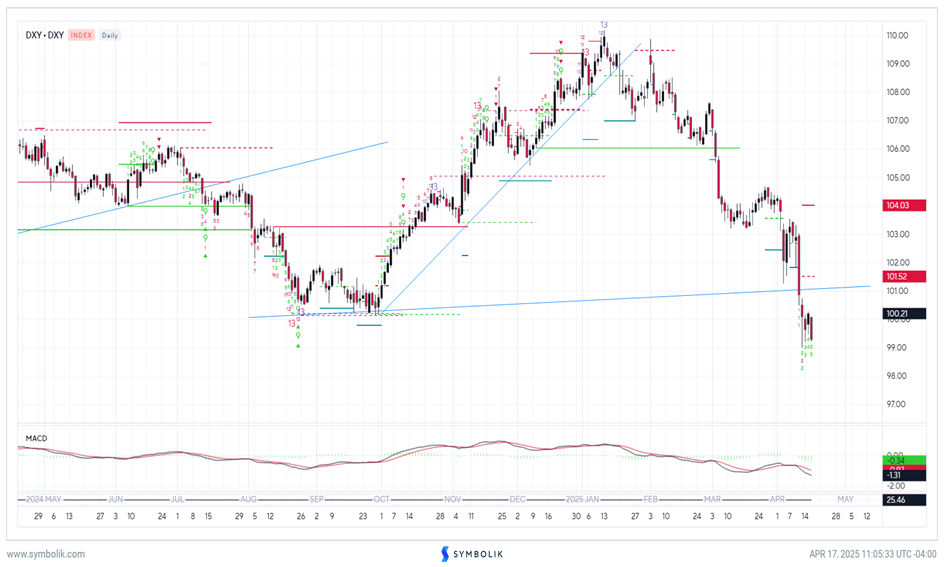
India’s Equity ETF rises to its highest levels of 2025
Interestingly enough, India’s Equity ETF INDA 0.02% (Ishares MSCI India ETF) rose to new three-month highs this week, hitting the highest levels of 2025.
While some investors have concerns about possible weaker corporate profits in India given expected growth deceleration, it’s difficult to use that argument as a reason to avoid India’s Equity market at present.
As shown below, the 14% selloff in India held where it needed to technically before starting to turn back higher.
The ability to have exceeded March’s peaks at $52.15 is thought to be particularly positive for INDA for the weeks ahead, and similar price action (hitting new multi-month highs) has also been seen in Mexico’s ETF from Ishares MSCI (EWW 0.27% )
Thus, while many investors remain concerned about the degree of tariff uncertainty, it’s important to point out that some of the direct beneficiary countries of these tariffs have seen their Equity markets turn sharply higher in the last few weeks.
Ishares MSCI India ETF
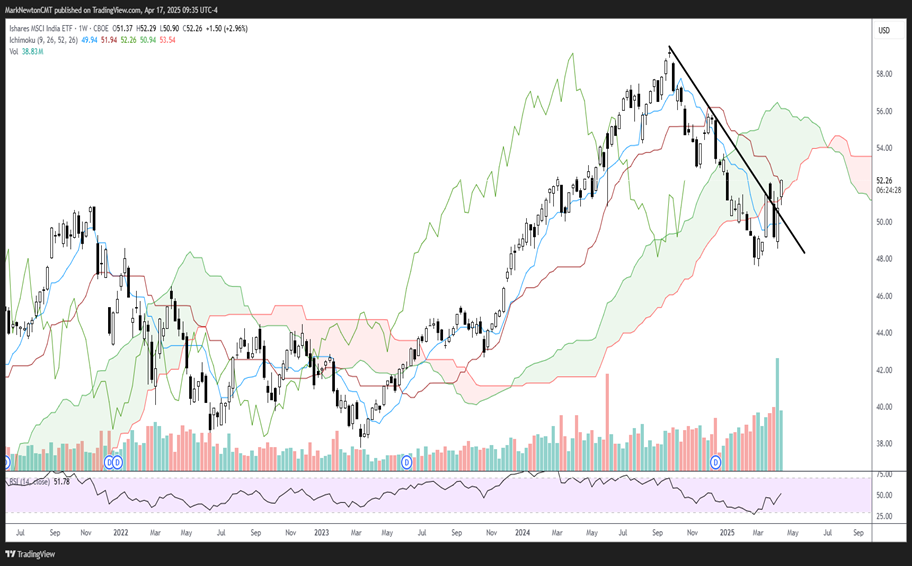
Bank of America’s April report shows sentiment at rare levels of bearishness
Interestingly enough, the latest Bank of America (BofA) global Fund Manager Survey (FMS) shows a very heightened level of negativity.
The sentiment poll below based on cash levels, asset allocation and global growth expectations fell to the lowest level since Fall 2023.
Moreover, the current level of sentiment has reached the fifth lowest level on record (only behind 2001, 2009, 2019, and 2022).
I view this to be a big positive with regards to adopting contrarian type thinking in light of excessive pessimism.
While investors seem to be retreating in their allocation to US Equities (which In the short-term has worked given US underperformance) I don’t view this as the right strategy for investors with a timeframe of longer than 1 month.
Cycles show US Equities to have begun a bottoming process that should lead prices higher into late May as part of a rally back to potential new highs into August of this year. (Based on cyclical projections) Thus, adopting a positive view given improvements in breadth, momentum, and sector participation at a time when sentiment remains quite negative seems prudent.
BofA Global FMS investor sentiment sinks to 5th lowest level on record
